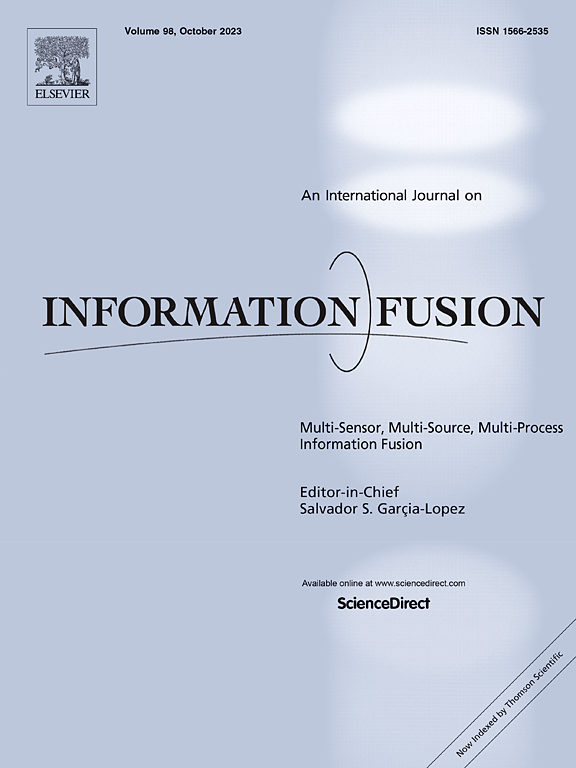FSVS-Net: A few-shot semi-supervised vessel segmentation network for multiple organs based on feature distillation and bidirectional weighted fusion
IF 14.7
1区 计算机科学
Q1 COMPUTER SCIENCE, ARTIFICIAL INTELLIGENCE
引用次数: 0
Abstract
Accurate 3D vessel mapping is essential for surgical planning and interventional treatments. However, the conventional manual slice-by-slice annotation in CT scans is extremely time-consuming, due to the complexity of vessels: sparse distribution, intricate 3D topology, varying sizes, irregular shapes, and low contrast with the background. To address this problem, we propose a few-shot semi-supervised vessel segmentation network (FSVS-Net) applicable to multiple organs. It can leverage a few annotated slices to segment vessel regions in unannotated slices, enabling efficient semi-supervised processing of the entire CT sequences. Specifically, we propose a feature distillation module for FSVS-Net to enhance vessel-specific semantic representations and suppress irrelevant background features. In addition, we design a bidirectional weighted fusion strategy that propagates information from a few annotated slices to unannotated ones in both opposite directions of the CT sequence, effectively modeling 3D vessel continuity and reducing error accumulation. Extensive experiments on three datasets (hepatic vessels, pulmonary vessels, and renal arteries) demonstrate that FSVS-Net achieves state-of-the-art performance in few-shot vessel segmentation task, significantly outperforming existing methods. We collected and annotated three vessel datasets, including clinical data from Tsinghua Changgung Hospital and public sources (e.g., MSD08), for this study. In practice, it reduces the average annotation time from 2 h to 0.5 h per volume, improving efficiency by 4. We release three organ-specific vessel datasets and the implementation code at: https://github.com/YqunYang/FSVS-Net.
FSVS-Net:一种基于特征蒸馏和双向加权融合的多器官半监督血管分割网络
准确的三维血管测绘对于手术计划和介入治疗至关重要。然而,由于血管的复杂性:分布稀疏、三维拓扑复杂、大小不一、形状不规则、与背景对比度低,传统的手工逐片标注在CT扫描中非常耗时。为了解决这一问题,我们提出了一种适用于多器官的半监督血管分割网络(FSVS-Net)。它可以利用少量带注释的切片来分割未注释切片中的血管区域,从而实现对整个CT序列的高效半监督处理。具体而言,我们提出了FSVS-Net的特征蒸馏模块,以增强血管特定的语义表示并抑制不相关的背景特征。此外,我们设计了一种双向加权融合策略,该策略将信息从CT序列的两个相反方向上的少量带注释的切片传播到未注释的切片,有效地模拟3D血管连续性并减少误差积累。在三个数据集(肝血管、肺血管和肾动脉)上进行的大量实验表明,FSVS-Net在少量血管分割任务中取得了最先进的性能,显著优于现有方法。在本研究中,我们收集并注释了三个血管数据集,包括来自清华长庚医院和公共来源(如MSD08)的临床数据。在实践中,它将平均标注时间从每体积2小时减少到0.5小时,效率提高了4倍。我们在https://github.com/YqunYang/FSVS-Net上发布了三个特定器官的血管数据集和实现代码。
本文章由计算机程序翻译,如有差异,请以英文原文为准。
求助全文
约1分钟内获得全文
求助全文
来源期刊

Information Fusion
工程技术-计算机:理论方法
CiteScore
33.20
自引率
4.30%
发文量
161
审稿时长
7.9 months
期刊介绍:
Information Fusion serves as a central platform for showcasing advancements in multi-sensor, multi-source, multi-process information fusion, fostering collaboration among diverse disciplines driving its progress. It is the leading outlet for sharing research and development in this field, focusing on architectures, algorithms, and applications. Papers dealing with fundamental theoretical analyses as well as those demonstrating their application to real-world problems will be welcome.
 求助内容:
求助内容: 应助结果提醒方式:
应助结果提醒方式:


